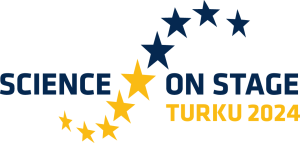Projects combining natural science with other disciplines, e.g. science, technology, engineering or mathematics with arts, music, sports, history, etc.
(E1) A Story of a Wealthy Man – How Energy of Uranium Was Discovered and How It Was Used, T. Wróbel (PL)

Institution: Herbert Secondary School
Subjects: Physics, art, cosmology, history
A history of uranium in a form of a theatre play, which is told by uranium himself. Uranium tells his story from the very beginning, that is his birth in a supernova explosion, until nowadays. Nobody knew what big fortune uranium had till 1938 when 0.Hahn, F. Strassmann, and L. Meitner split the atom and discovered how „wealthy“ he was. Uranium tells us how people, against his will, used his energy (money). Uranium wants to share his fortune but only for the good of humanity.
Are we ready? The inspiration for this story was the essay written by A. Einstein „E=mc2“ in which Einstein compares energy hidden in matter to a rich man. We don’t know that he is wealthy if he doesn’t spend his money.
(E2) Algae-pearls – The lights of the sea, B. D’Haese & I. Tavernier (BE)

Institution: Flanders Marine Institute & Flanders Marine Institute and Sint-Lodewijkscollege Bruges
Subjects: Physics, biology, chemistry, STEM
(1) The STEM project, ‘WALL-E and the last plant on Earth,’ emphasizes the vital link between plants and life on Earth. Students cultivate algae and monitor growth through microscopy. They develop a photosynthesis experiment. The algae are encapsulated in algae pearls. Photosynthesis is measured indirectly using pH. At the stand, participants can observe the formation of the pearls.
(2) In the dark depths of the ocean, bioluminescent organisms emit their own light for mating, hunting, defense and deterring predators. You may have seen the mesmerizing blue flashes of sea sparkle, at the end of a warm and calm day. At the stand, we’ll create the magical blue glow.
(E3) ARTificial, Ç. A. Esendemir (TR)

Institution: Edebali Anatolian High School
Subjects: Computer science/ICT/IT, English, art
The project focuses on elevating the descriptive language proficiency of female students by integrating art with DALL-E, an AI system capable of generating lifelike images. Students engaged in both physical and virtual art exhibitions, meticulously document details like color and form in their notes. Subsequently, they translated their subjective interpretations of the artworks into English descriptions. Leveraging DALL-E, these descriptions were transformed into visuals, showcased at the school, and shared on a dedicated project blog. The project has demonstrated notable enhancements in students’ vocabulary and grammar as they navigated the stages of AI-supported art creation.
(E4) Attracted by Magnets, E. van Kemernade (NL)

Institution: Huygens Lyceum
Subjects: Physics, technology, engineering, science
The project subject is to create a sustainable construction that moves with magnets in daily life. For example an elevator or a train/underground or something usable in infrastructure, companies, hospitals etc. The only thing you need during this project is a couple of magnets and some craft materials. Its a combination of the subjects physics, science, designing, engineering and technolgy. During the project the students (12 -13 yrs old) will do research about how magnetism and electromagnetism work and how they are used in daily life. After the research they have to design a new sustainable construction that can be used in daily life.
(E5) Bee Api & Face, C. Desterbecq & F. Riviere (FR)

Institution: Lycée Alexis Monteil (Rodez)
Subjects: Biology, mathematics
Do bees recognise their beekeeper by facial identification?
This unusual question not only provides an opportunity to develop a complete, innovative and evolving experimental approach with students, but also leads the public to become aware of bees’ intelligence and their vulnerability. By exploiting the floral constancy and insatiability, we note the performance of foragers in recognising, from a large selection, a given beekeeper whose face photos are the only ones associated with a reward. From the bees’ behaviour and performance, we can conclude that, under the experimental conditions and after a large number of trials, the foragers are able to discriminate between beekeepers’ faces.
(E6) Chemistry Journey Around the World, L. Machová & P. Machová (CZ)

Institution: Gymnazium Česká Lípa
Subjects: Physics, chemistry, geography
The “Chemistry Journey Around the World” project aims to popularize science among children and young people, specifically focusing on the chemistry component of a joint physical-chemical project involving two Czech high schools. This project serves as a scientific popularization initiative across multiple school subjects, including geography, chemistry, and physics. The project explores typical snacks, plants, and products from various countries, utilizing them as the basis for a diverse range of physical and chemical experiments.
(E7) Chromatography Embodiment. A CLIL approach to outdoor learning and outreach, T. Cecchi (IT)

Institution: ITT Montani
Subjects: Chemistry, mathematics, videomaking
We dramatise the most useful analytical technique, chromatography, through an immersive CLIL experience of embodiment and gamification based on a motto valid for both people and molecules: Tell me how you walk and stop; I’ll tell you who you are! To separate a crowd of mixed people (or molecules) we make them move; they won’t all reach the finish line together. Musicians mime a detector for the (i) qualitative analysis, playing different notes for different molecules (ii) quantitative analysis, sounding louder for greater amounts. Learning is easy if complex principles are made real. Videomaking engaged the students in important outreach events, science festivals and competitions.
(E8) Clay and science, H. G. Palsdottir (IS)

Institution: Langholtsskóli
Subjects: Mathematics, technology, science, geography, pottery
The Curriculum I teach creates opportunities for students to discover, learn and use new diverse knowledge with an emphasis on increasing students’ interest and understanding while collaborating with their studies in other subjects at Langholtsskóli primary school.
Students from the 5th to 7th grade create ceramic art mixed with geology, mathematics, independent thinking and problem solving. Some examples include learning about the origin of pottery materials in Icelandic nature and working with volcanic materials, using maths to create objects in a 3D space and finally independently creating and overseeing a project from concept to reality.
(E10) Creation of Self-Stressed Constructions, Y. Hulyi & L. Bezperstova (UA)

Institution: School No 2 for Levels I – III Gorishni Plavni Poltava region & School No 3 for Levels I – III named after V. O. Nizhnichenka Gorishni Plavni Poltava region
Subjects: Physics, biology, mathematics, technology, architecture, art
The project demonstrates an original teaching method that allows students to improve design, engineering skills, and three-dimensional imagination by creating self-stressing tensegrity models. The principle of constructing such structures is based on the use of their stability and balance. Students can create various models, which demonstrate their transformation and understanding of the principle of minimum potential energy.
(E11) B.I.C.E.P.S. – New quality for sports and you, M. Ginko (PL)

Institution: Technical Secondary School
Subjects: Physics, mathematics, computer science/ICT/IT, mechatronics
B.I.C.E.P.S is a safe and certified electrical appliance that helps in practicing sports, the gym as well as in sports at home. B.I.C.E.P.S’s role is to help people to stay focused and perform exercises in an efficient and accurate way rather than focusing on counting of performed exercises. The appliance is small and easy to use. You just put it on a weight bar using hook and loop fastener, turn on a button and wait for a signal that the device is ready to use. It is an original project created using Scratch. The device is based on the microcontroller Arduino Nano. There is a triaxial accelerometer built in to count the number of repetitions, the switch, the display and the speaker.
(E12) Can we eat expired plain yoghurt, E. Millour (FR)

Institution: Collège Charles le Goffic
Subjects: Biology, technology
Once past its use-by date, is plain yoghurt still eatable? Nearly half the people questioned throw it in the bin! We set out to develop an easy-to-produce test, using commercially available products, to show whether yoghurt is (or isn’t!) still eatable. We worked on the parameters involved in producing yoghurt: temperature, type of milk, fermentation time, etc. Based on these elements, we focused our research on monitoring the pH of yoghurt. We ended up using a red cabbage juice gel.
(E13) Crime scene investigation, S. Bruks (SE)

Institution: Grubbeskolan
Subjects: Science
The crime scene investigation is an exciting mixture of theatrical skills, pupil collaboration and natural science. The students face a brutal murder scene inside the research lab of a hospital. They are presented with a number of suspects, and six different evidence materials that lead them to the murderer and the victim. With joined forces and the combined use of knowledge in biology the students solve and later explain the murder. The social crisis of the development of new antibiotics is at the heart of the crime scene and blood analysis, DNA, microscopy, and fingerprints sort out the suspects one by one. An investigation of both the crime but also the art and beauty of natural science.
(E14) The Art of Chemistry Across the Ages, P. Egan (UK)

Institution: Brighton College
Subjects: Chemistry, environmental science, photography, art
In this project, a chemical solution was used to create a simple type of photo paper: cyanotype paper. The photo paper was created by older chemistry students, who prepared the solution and applied it to plain paper. The older students then helped younger students to explore the natural world by helping them find suitable objects, like leaves, and placing them on the photopaper to create blue-and-white negatives. This allowed the students to enjoy the magic of chemistry in an artistic activity. The full activity interwove different types of motivating factors, like responsibility, achievement, and a sense of awe into a stand-out experience for all.
(E15) ECOPLATE PROJECT: Towards a New Energy Model, C. Illarramendi (ES)
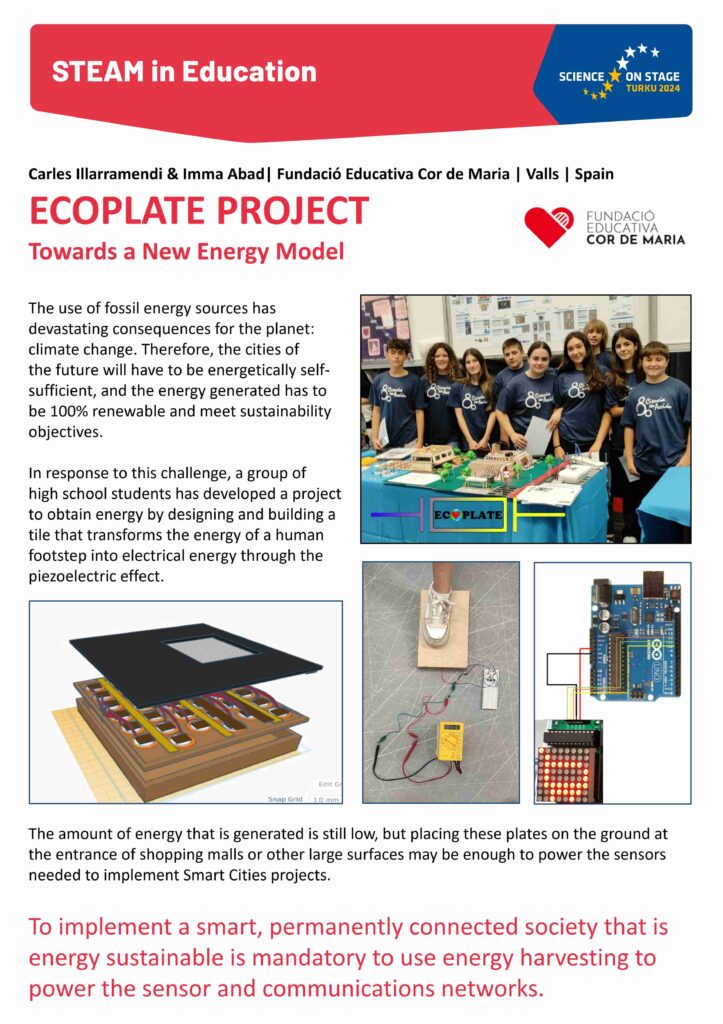
Institution: Fundació Educativa Cor de Maria
Subjects: Mathematics, computer science/ICT/IT, technology, engineering, science, arts
The use of fossil energy sources has devastating consequences for the planet: climate change. Therefore, future cities will have to be energetically self-sustaining, and that energy generated will have to be 100% renewable and meet sustainability goals. Wanting to respond to this challenge, a group of secondary students has set out to develop a project to obtain energy at the entrance of shopping malls or other large surfaces by placing plates on the ground that transform the tread into electrical energy through the piezoelectric effect. The amount of energy that is generated is still quite low, but it may be enough to power the sensors needed to be able to implement Smart Cities projects.
(E16) Exploring Garbon Sinks – Study of Sea, Soil, Forest and Swamp, S. Aspholm, M. Niemi & K. Lücke (FI)

Institution: Hyvinkään lukio
Subjects: Chemistry
In our optional course students will learn by doing though excursions about carbon sinks (marine, soil, forest and swamp). As a rule, the classes will be held outside the timetable and school building. The sea as a carbon sink was explored by sailing at The Baltic Sea on the Shooner Helena. The soil as a carbon sink was studied on an organic farm in Hyvinkää. The third excursion was to Helsinki University Hyytiälä forest station where they are measuring ecosystem-atmosphere relations. The destination of the last trip was to the swamp. During the course, students carry out their own specific tasks. They compile a portfolio of the data and experiences they collected.
(E17) From knowledge of chemistry to a useful project, N. Žuman (SI)

Institution: Gimnazija Franca Miklošica Ljutomer
Subjects: Chemistry, interdisciplinary
Modern chemistry teaching is based on experimental and problem-oriented learning. Many secondary school students find it difficult to understand chemistry and often wonder where and how they can apply the theoretical knowledge which they have acquired in their everyday lives.
With the help of outside professionals, we have therefore tried to enrich the learning
content of the course with activities in which our students put their theoretical knowledge into practice by making different products. In doing so, they developed their creativity and made their knowledge of the subject matter meaningful through experiential learning.
(E18) History in STEM format, O. Davydova (KZ)

Institution: Secondary school No. 2 of Arshaly village
Subjects: Mathematics, computer science/ICT/IT, history
History in STEM Format is a template for creating a history lesson where students act as historical scientists who will take part in filming a historical film.
Young experts will check the script of the film for historical errors, perform mathematical calculations, use neural networks to generate a poster and make props or decorations, and then make a short film.
What is the use of History in STEM format? This is a vivid, memorable lesson that focuses on functional literacy. It is easy to repeat, because you can shoot a historical movie about any event. It has a clear structure, which greatly simplifies the planning process, and also does not require material costs.
(E19) Da Vinci’s Bridge, L. Acmola & E. Tipau (RO)
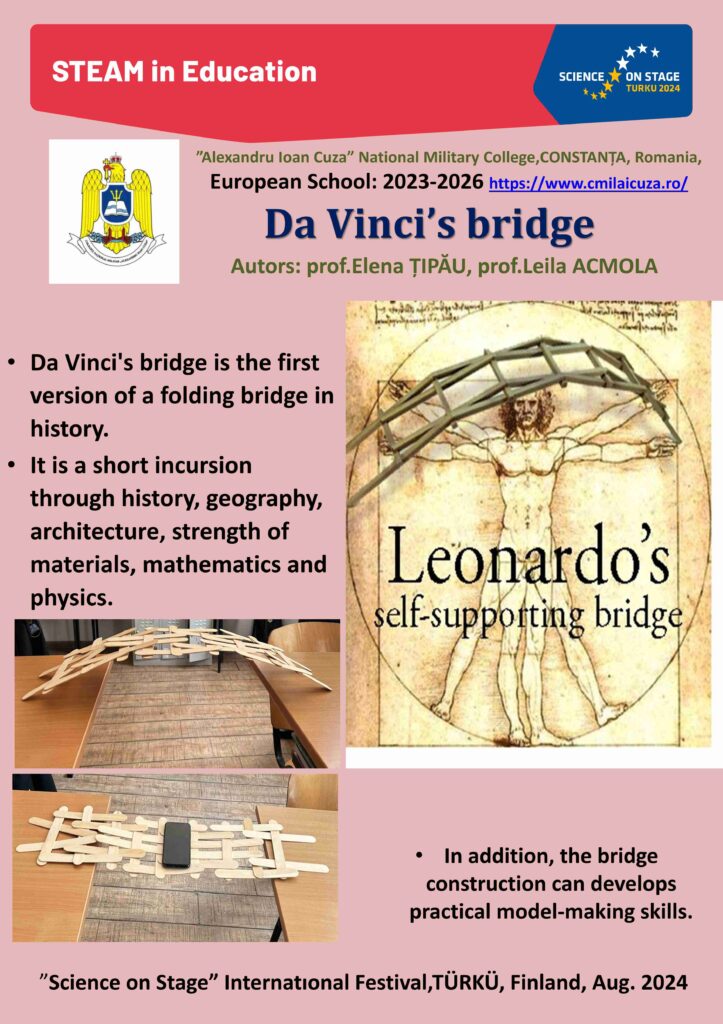
Institution: Colegiul Național Militar “Alexandru Ioan Cuza”
Subjects: Physics, mathematics, computer science/ICT/IT, history
The project makes a foray into history: Turkish sultan Baiazid II calls for the construction of a bridge over the Dardanelles. Leonardo da Vinci plans to build it through the Golden Gulf of the Istanbul Horn. The project did not materialise because the Ottoman leader refused the project. After a long time, the draft sketch was discovered. After the historical presentation, students will learn how to build and make small models.
Using Google Maps, students will study the geographical appearance of the Golden Gulf of the Istanbul Horn and will determine where the bridge could have been built.
Students will be able to compare the dimensions of the model with the real dimensions of the bridge.
(E20) Light Painting, A. Vacková & K. Lipertová (CZ)
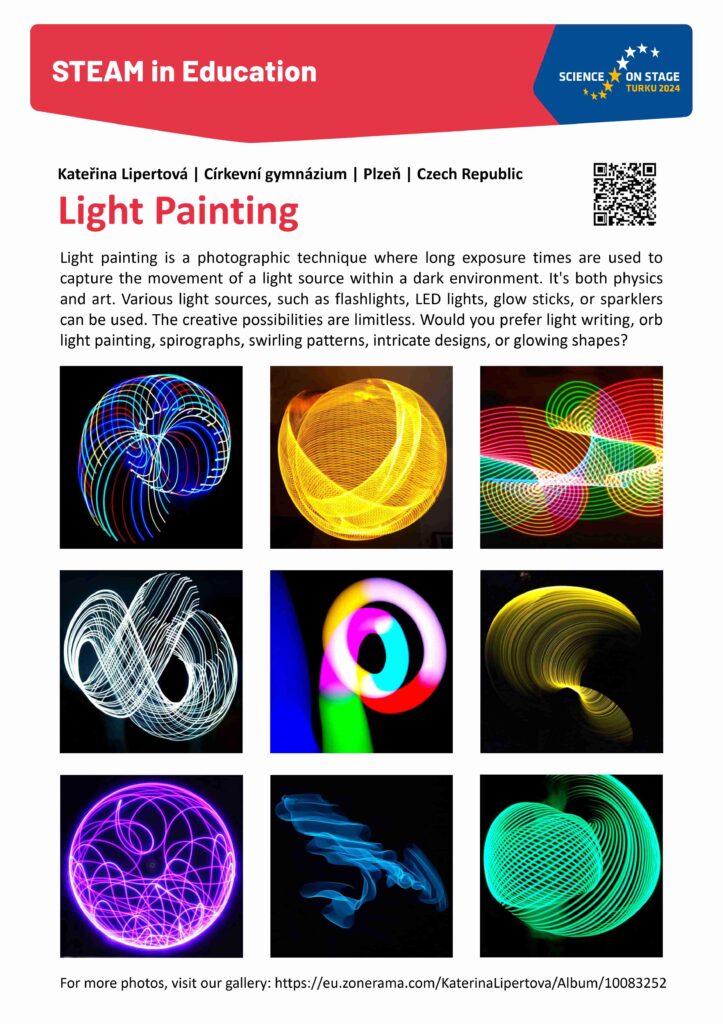
Institution: Církevní gymnázium Plzeň
Subjects: Physics, art
Light painting is a photographic technique where long exposure times are used to capture the movement of a light source within a dark environment. It’s both physics and art.
Various light sources, such as flashlights, LED lights, glow sticks, sparklers, or even fire, can be used.
The creative possibilities are limitless, which is why this photography method is so popular among children during physics and art classes at our school.
Would you prefer light writing, orb light painting, spirographs, swirling patterns, intricate designs, or glowing shapes?
And, additionally, the super simple RGB mixer will be shown.
(E21) Mathemagics, J.-B. Aubin (FR)
Institution: INSA-LYON
Subjects: Mathematics
Mathematics is full of astonishing properties. These properties can be used to create magic tricks, for example, to calculate mentally at uncommon speed, but also to influence, predict the future or even… read minds! As Bertrand Russel puts it :”The world is full of magical things patiently waiting for our wits to grow sharper.”
(E22) The use of plant material in obtaining bioplastic, F. Floarea (RO)

Institution: Ana Aslan Technical College
Subjects: Biology, chemistry, geography, envorinmental science
The term plastic refers to those materials, synthetic products of organic, inorganic or mixed nature, which can be easily processed into different shapes, hot or cold, with or without pressure. Bioplastics have many advantages, such as reducing the carbon footprint, ensuring energy savings, not involving the consumption of non-renewable raw materials, the reduction of non-biodegradable waste, and not containing additives harmful to health. Traditional plastic is present in all aspects of human life, being indispensable precisely because of its properties: high resistance, impermeability, ease of use, low production costs.
(E23) Our Plastic Pollution Pledge, C. Cross (UK)

Institution: St Agnes Academy
Subjects: Mathematics, technology, science, literacy, art, music, history, geography
‘Plastic Pollution Pledge’ is a whole-school project that aims at exploring innovative solutions to tackle the problem of plastic waste. Students develop an awareness of the issue of global plastic pollution through a variety of scientific investigations, ranging from studying living things affected by the negative impact of plastic waste to investigating the properties of plastics. We have made many opportunities to make cross-curricular links as we delve further into this project, including persuasive writing, maths, D.T, geography, music and art. We inspire our future scientists make a difference and be part of a sustainable future.
(E24) Interdisciplinary subject – research, M. Godec (SI)

Institution: Gimnazija Franca Miklošica Ljutomer
Subjects: Interdisciplinary
Our school provides 6 optional subjects for 2nd and 3rd year students, one of which is the Interdisciplinary Course – Research. The primary objective is to teach students various research approaches and methods while developing lifelong skills, such as data management, argumentative writing, public speaking and presenting their work effectively. In 3rd year, students select a field of interest and a school mentor who guides them through their research project. Students also participate in research tasks at the Meeting of Young Researchers. This event allows them to present their work publicly. We encourage them to disseminate their findings and prepare an article.
(E25) Looking for Treasure, M. Havu (FI)
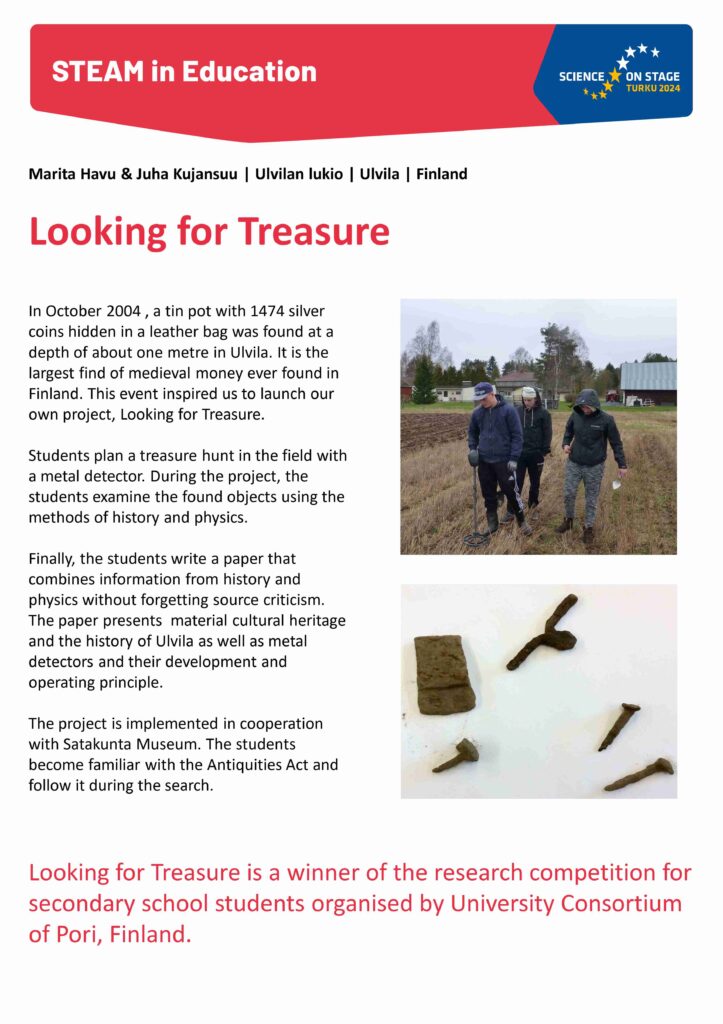
Institution: Ulvilan lukio
Subjects: Chemistry, physics
Students plan a treasure hunt in the terrain with the help of a metal detector. During the project, the students examine the found objects using the methods of history and physics. Finally, the students write a study that combines information from history and physics without forgetting source criticism. The study presents the history and material cultural heritage of Ulvila, metal detectors and their development and operating principle. The project is done in cooperation with Satakunta Museum. The students visit the museum and the museum representative also checks the finds. The students become familiar with the Antiquities Act and followed it during the search.
(E26) Quieter, I. Hokušienė (LT)

Institution: Seduvos gymnasium
Subjects: Physics, mathematics, technology, art & design
A textile interior piece was created by 5th-8th-grade students (TEXTILE ART AND DESIGN), discussing its purpose, value, benefits, and impact on well-being. The working method was demonstrated, resulting in a final product crafted through the individual efforts of students from different classes. Through an experiment (PHYSICS), the impact of the handmade item on the room’s noise level was determined. Various calculations (MATHEMATICS) were conducted to optimise work efficiency and craft creation costs. Sustainability was prioritised in the creative process, incorporating recycled materials, with an emphasis on community involvement and environmentally conscious use of secondary materials.
(E27) Secrets of a glass of water, I. Bezhanova (GE)
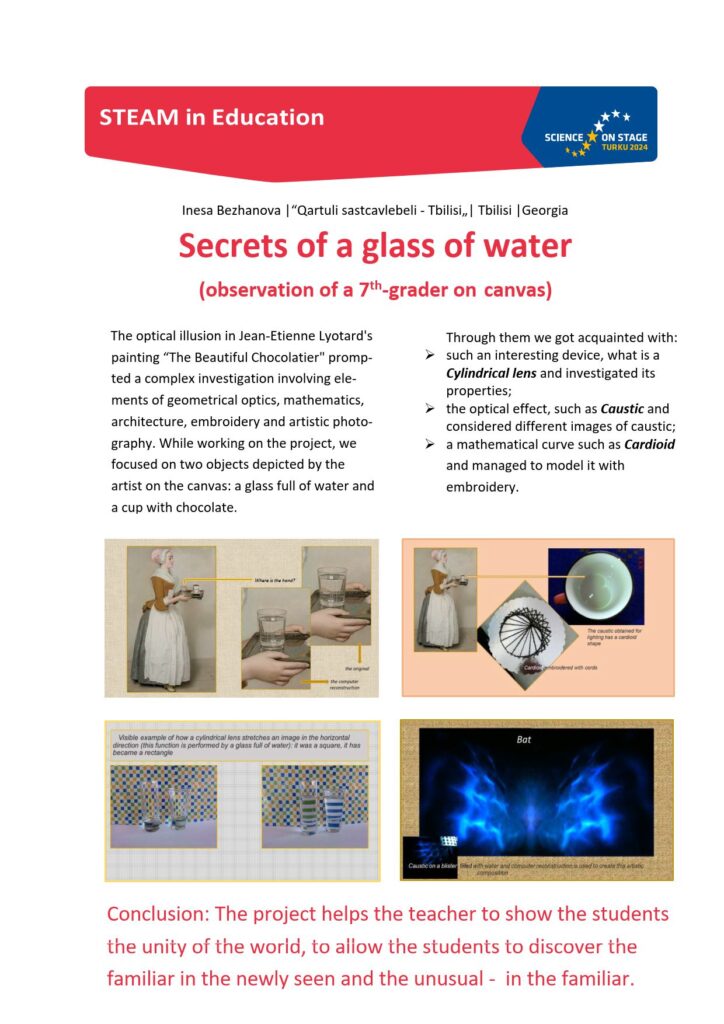
Institution: Qartuli sastsavlebeli-Tbilisi
Subjects: Mathematics, geometric optics, architecture, embroidery, artistic photography
The optical illusion in Jean-Etienne Lyotard’s painting The Beautiful Chocolatier prompted a complex investigation involving elements of geometrical optics, mathematics, architecture, embroidery and artistic photography. While working on the project, we focused on two objects depicted by the artist on the canvas – a glass full of water and a cup with chocolate. Through them we got introduced to: 1) such an interesting device as a cylindrical lens and investigated its properties
2) the optical effect such as caustic, explored its forms and created art composition using this effect; 3) a mathematical curve such as cardioid and managed to model it through embroidery.
(E28) Shedding “light” on a Picasso! G. Chatzisavvas & K. Giannakoudaki (GR)

Institution: 1st High-school of Heraklion, Crete & Model General Lyceum of Heraklion, Crete
Subjects: Mathematics, technology, engineering, science, arts
Our work intends through a STEAM teaching approach to introduce students to multispectral imaging. Multispectral imaging is a process of creating digital visual images of an object by using different, but well-defined wavelength regions of the E/M spectrum, which include the visible and extend beyond it into the ultraviolet and near-infrared regions. The visualization of various layers of artworks created by students is attempted by using a simple, low-cost experimental set-up. The advantage of this non-invasive technique is that students realize the interaction of light with matter, the interdisciplinarity of knowledge and also the applications of basic principles of physics in practice.
(E29) Simple Machines, G. Chatton & D. Schumacher (CH)

Institution: HEP Fribourg
Subjects: Physics, technology, sport, history
Our project is to get elementary school pupils to discover and explore simple machines from an interdisciplinary perspective. The starting point for the exploration is to ask students questions about the historic buildings in their own town. Over time, to build their homes, humans learned to use different materials, including stones weighing several hundred kilograms. How did they do it? Then, in the sports hall, various devices (pulleys, ropes, skateboards) invite students to investigate several problem situations with their bodies. Back in the classroom, they continue with their experiments, taking measurements on simple machines to bring out the first laws of physics.
(E30) Sounds and lights – A sensory experiment in “Parque D. Carlos I and Mata Rainha Dona Leonor“M. Conceição Vidigal & M. Pimenta (PT)

Institution: Escola Secundária Rafael Bordalo Pinheiro
Subjects: Physics, biology, history, Arts
This project involved creating and applying a multidisciplinary learning guide for eighth graders used on a science field trip to two historical sites in Caldas da Rainha, Portugal. The activities involved articulating the physics and biology syllabus, namely the study of sound, light and waves and the study of biodiversity. The students used their lab notebooks, guide, and apps previously installed in their cell phones, developing skills in communication and critical thinking, as well as consolidating concepts studied in class. The experiment culminated in an interactive exhibition held by the students to raise awareness for natural heritage preservation and planet sustainability.
(E31) Chemistry Through the STEAM Method, V. Ignatescu (RO)

Institution: Philadelphia Theoretical High School
Subjects: Physics, biology, chemistry, mathematics, technology, art
CHEMISTRY through the STEAM method proposes the study of a particularly important metal, copper, with STEAM notions:
Sciences: the presentation of minerals containing this metal, formulas, experimental demonstrations; Technology: presentation of life applications;
E-Engineering: experimental demonstration of solution electrical conductivity;
Art: mineral associations with butterflies, puzzles;
Mathematics: preparing solutions of certain concentrations, solving applied problems.
The activity goes through lesson stages, an approach intertwined with gamification, laboratory experiments, problem arising. Students work in the lab like scientists observing, asking questions, and issuing conclusions.
(E32) The Mobile Model of the Solar System with Photon and SkriBot Robots, R. Pieluchowski (PL)

Institution: Primary School Number 6
Subjects: Mathematics, computer science/ICT/IT, technology, engineering, science, art
The project involves making a mobile model of the Solar System with Photon robots and SkryBot, reproduced on a scale ensuring the location of all the planets on the small space – e.g. a gym. The planets of the solar system were printed in a school 3D printer, painted and then mounted on the Photon robots. Showing this on a physical model, at the appropriate scale, will have an impact on imagination and made us think. The presentation of each planet as a moving Photon robot on the chosen orbit, equipped with a model of a given planet, will have educational function for primary and secondary school students.
(E33) The folding electric motorcycle, N. Bonnet & R. Moulin (FR)

Institution: Lycée Saint Denis
Subjects: Engineering
I asked my students (aged 17/18) to think about a project that could be carried out over a school year. The project had to be societal and innovative. To these prerogatives, they added that of eco-design.
They suggested this motorcycle attractive to young people who live in an apartment, foldable to enter an elevator shaft.
They carried out everything themselves: Functional analysis and European regulatory documents, calculations, search for solutions, 3D design, 3D model, laboratory wind tunnel test, manufacturing plans, nomenclature, manufacturing of welded chassis, mechanical assembly, electrical wiring, writing of the test procedure, then tests in real conditions and analysis of the results.
(E34) The Manufacture STEM-LAB for New Ukrainian School (NUS), T. Mizichenko & O. Buturlina (UA)

Institution: Dnipro Academy of Continuing Education
Subjects: Mathematics, computer science/ICT/IT, technology, science, art
The main goal is to develop simple, useful educational tools and hands-on activities for STEM teachers at the secondary school level.
If the STEM teachers have problems with teaching techniques, we are prepared to help them methodically using cheap materials and household objects during the lessons and beyond. We spread and share the ideas and IB teaching techniques among the secondary schools in all regions of Ukraine.
Our team has also created and published a series of textbooks, which visually demonstrate examples of hands-on activities for pupils, developing their research and experimental skills. STEM-LAB gives practical knowledge about motion, forces, momentum and space.
(E35) Art in Engineering – Europe in Three Dimensions, U.-R. Ylitalo & J. Martindale (FI)
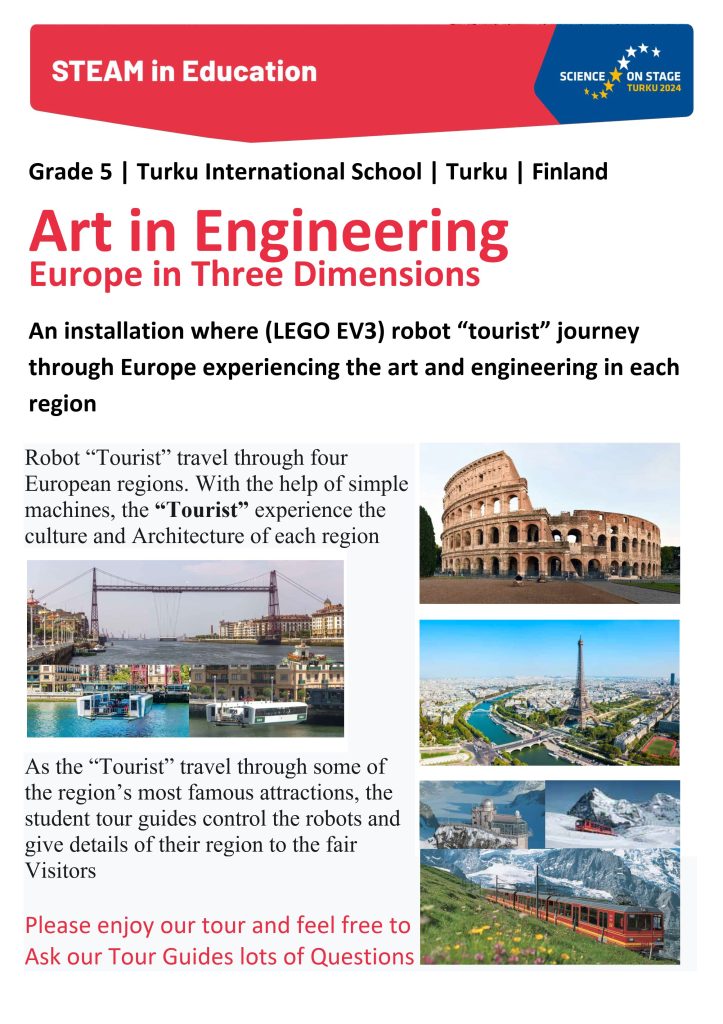
Institution: Turku International School
Subjects: Mathematics, computer science/ICT/IT, environmental studies, English, visual art
The aim of the project is to create an installation for the Turku International School Travel Fair where LEGO EV3 robot tourists journey through Europe experiencing the art and engineering in each region.
(E36) The physics of musical instruments: A waves perspective of the musical timbre, J. Carette (BE)

Institution: De l’autre côté de l’école
Subjects: Physics, music
Our brain is trained to distinguish very easily two different musical instruments playing the same note, and to recognize people’s voices. Through a guided experimentation of various musical instruments, this project’s goal is to show the physics behind the notion of musical timber. Why does a flute sound like a flute? What are harmonics? How does our brain “hear” different notes? What is the link between an instrument’s sound and its geometry? What do animals hear? Why is a noise not as soft to hear as a musical sound? Building bridges between musicology, biology and physics, this experimental setup was initially designed for 15-18 years old, but can be adapted to all ages and science levels.
(E37) The Power of Lichens and Moss, T. Mason (IE)
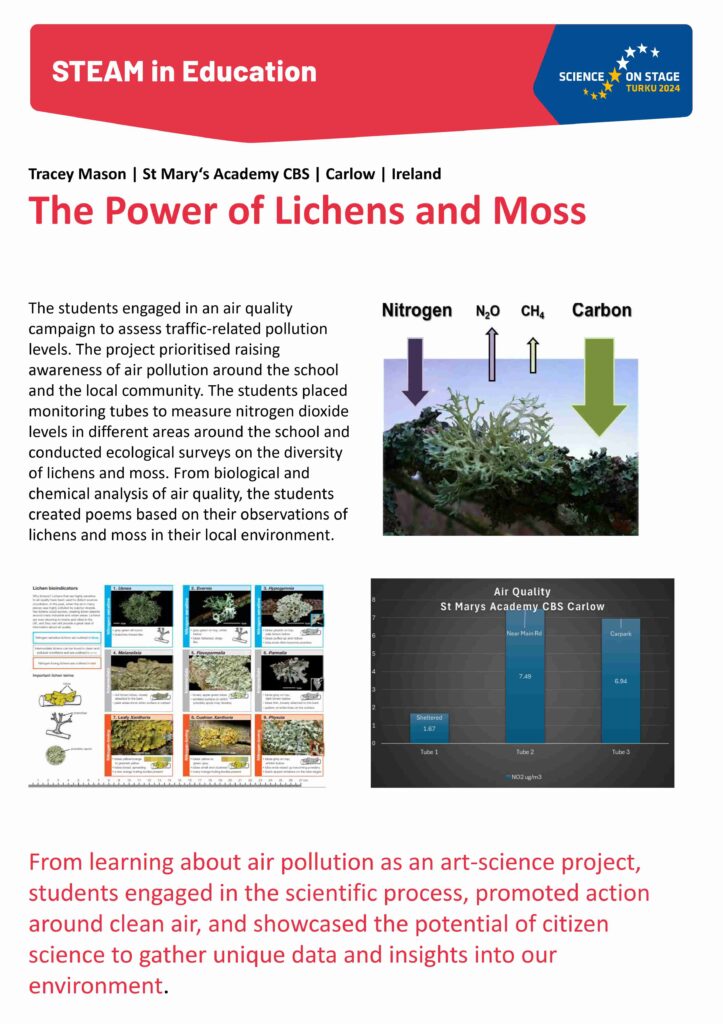
Institution: St Mary’s Academy CBS
Subjects: Mathematics, technology, science, arts
This project is about the importance of lichens as biological indicators of air quality and the ability of moss in reabsorbing carbon dioxide from the atomosphere. Moss also has the ability to reduce soil erosion due to its ability to bind soil particles. Ireland is currently undergoing its biggest reverse-engineering project ever undertaken by the State. Since 1946, draining the bogs to extract peat was occuring. Ireland will spend the next two decades, rewetting them in an attempt to reverse the process and increase biodiversity and reduce carbon emissions.The project will showcase learning opportunities for students to actively engage with some climate issues surrounging air and soil.
(E38) Mini meteorological station for our school, M. Pető (RO)

Institution: Székely Mikó High School
Subjects: Physics, computer science/ICT/IT
The Arduino microcontroller is an interesting device for students, which is not included in the school curriculum. Therefore, through special physics projects, students will learn about microcontrollers and learn how to design and build a mini meteorological station that measures air pressure, temperature, light intensity and humidity. The data collected is used for biology or geography class, and for scientific research. During the planning process, they acquire engineering knowledge, and become familiar with the basics of applied IT and 3D design. They will be able to meet the challenges of the 21st century, think creatively, communicate easily and work well in a team.
(E39) Pisara/Drop- Art Garden, K. Tauriainen & M. Haapakangas (FI)

Institution: Turun Suomalaisen Yhteiskoulun lukio
Subjects: Biology, visual arts
The Art Garden is an aesthetic and ecological recreational area on the school premises. It enhances the school’s ambiance by focusing on themes such as sustainable development, biodiversity, and creative urban culture as well as the ecological and innovative design of future environments. The goal is to explore the possibilities of integrating biology, artistic thinking, design, and environmental education.
The garden features uniquely designed planting containers, insect hotels and butterfly feeders. Students have created artworks depicting endangered species, incorporating AR and 3D technologies. Biodiversity is supported through features such as a meadow and pollinator-friendly plant species.
(E40) The Ukrainian National Drink UZVAR, D. Shustova & V. Kysylichyna (UA)

Institution: Educational complex of comprehensive school “Lyceum – “Leader“
Subjects: Biology, chemistry, mathematics, computer science/ICT/IT, geography, history, English, Ukrainian literature
The main goal of our project is using the STEAM approach to explain to primary school pupils Ukrainian culture and eating traditions. In the material life of the ethnic group, not only the culture of food plays a significant role, but also the culture of drinking: the production of beverages, their role in the food system, and the etiquette of their consumption. One of the most traditional Ukrainian drinks is called UZVAR. It is made from dried fruit and it is always served on Christmas Eve and other religious holidays. The drink symbolizes fertility, well-being and prosperity. The main tasks of the project are to research the ceremonial drink UZVAR, to popularize and save national traditions.
(E41) Physics as a Fairy Tale, D. Golubović & S. Šušulić (RS)

Institutions: School Sinisa Janic & School 8.Oktobar
Subjects: Physics, art
A Glass of Pure Water is a trilogy of experiments in hydrostatics and stories about a Freak who lives in the forest and drinks pure water. The first part, A Coin That Doesn’t Sink, is a group of experiments in which participants will be convinced that a steel needle floats on water, but so does a paperclip, a button and even a metal coin. The second part, The Bottomless Glass, is a glass full of water in which, even though it is full to the brim, you can insert a thousand and one pins. And for the miracles to be complete, the Stranger will bring clean water in a sieve to the Queen in the last part, which is called Sieve and Sieve.
(E43) Ötzi, F. Speerli & R. Speerli (CH)

Institutions: Primarschule Wolfhausen
Subjects: Physics, mathematics, history, experimental archeology
Our school project, ‘Ötzi’, immerses students in the Stone Age to understand its life and culture. Through experimental archaeology, students engage in creating and using tools and weapons. Using the engineering method, they aimed to upgrade old technology with modern materials. Clothing is tested in adverse conditions like rain and snow, deepening comprehension of the era and creating memorable experiences. The goal is to enhance Stone Age technology and present results creatively. A captivating and educational project bringing history to life. Additionally, we crafted a comprehensive equipment set modeled after Ötzi, testing it during Alps hikes for practical insights.
